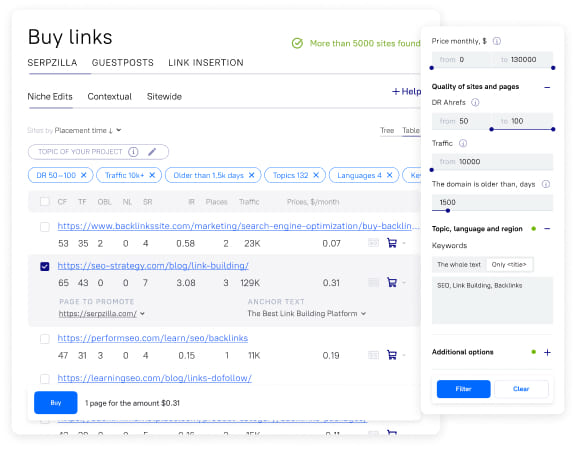Fully optimizing your SEO game across multiple locations can pose unique challenges that require particular, strategic approaches. As businesses expand their reach on an international level, the need for proactively understanding how to implement local SEO measures arises.
Challenges include tailoring content to various audiences, managing location-specific keywords, and ensuring consistent online visibility. In this article, we’ll explore proven strategies to navigate these hurdles, helping businesses enhance their online presence across multiple locations.
What is Multi-Location SEO?
Multi-location SEO allows you to adopt a strategic approach to search engine optimization that is tailored specifically for businesses wanting to operate in various geographic locations. In this case, success rests on proactively understanding five key components that can fully optimize your online footprint and boost organic traffic. Let’s dive into each element:
1. Analyzing Competitors and Local Markets:
Understanding the dynamics of the local market is key, particularly in understanding how you will perform against competitors on a more concentrated level. Be sure to conduct thorough research that can help you to identify regional trends, consumer behavior, and key regional competitors. These insights can help to form the basis of your SEO strategy, allowing you to implement an effective strategy immediately.
2. Collecting the Correct Semantic Core:
Building a fortified semantic core involves fully optimizing relevant keywords for every location. Consider localized content, cultural differences, and geographic language variations. Execute your SEO strategy based on the search habits of your target audience, keeping yourself relevant to search needs to increase the potential for high ranking.
3.Setting Up Subdomains, Subfolders, or Domain Zones:
Be sure to not overlook the structuring of your website, ensuring that it is appropriate for multi-location SEO strategies. Depending on the scale of your operations, you can choose between subdomains, subfolders, or domain zones to organize location-specific content. Doing so ensures that search engines can easily categorize and rank your pages for relevant local searches.
4. Set Up Hreflang and Translate the Site into Target Languages:
Hreflang tags remain essential in indicating both language and regional targets to search engines. Implementing these principles correctly will help search engines to serve the appropriate version of your content more effectively to users across multiple locations. Additionally, you can focus on translating your site into various target languages to enhance user experience, contributing to an improved SEO experience.
5. Get Regional Links:
Focus on building a robust backlink profile for each location – this is vital to regional success. Acquire high quality, relevant region-specific backlinks to fully strengthen your site’s authority across local search results. Try to resonate with local audiences by collaborating with local businesses, engaging in community events, and leveraging industry contents to acquire relevant local links.
Assessing Potential Impact and Demand in Advance
When embarking on a multi-location SEO strategy, you must conduct a thorough evaluation of potential impact and demand within each target region. This foundational phase is the brickwork in creating and crafting a fully effective and customized approach. Here, we offer a step-by-step guide to navigating this stage of the journey:
1. Evaluate Local Key Phrases for Demand:
Begin by using tools such as Ahrefs or Google Keyword Planner to fully scrutinize and understand local key phrases. By narrowing your focus down and analyzing a smaller region, you can effectively generate a list of relevant search terms. Also, assess the demand by examining both the frequency and context of these search terms to fully align with your local audience’s preferences.
2. Consider Conversion Metrics:
Understand that not all of the search volume you analyze will translate directly into website traffic. In fact, assume that only a fraction, usually 15-20%, of the identified volume may actually find its way into your site. This same logic can be applied to conversion rates – achieving a 3-5% conversion from incoming traffic is usually consider a positive outcome.
3. Analyze Competitors in New Markets:
Analyze your competitors and gain insights from those who have already established themselves throughout your newly targeted regions. Understand their entire business portfolio: operations, the depth of their regional reputation, and their intended growth size. Understanding these strategies helps you to understand market penetration and provides a benchmark for you to shape your own growth.
4.Evaluate Regional Infrastructure:
Focus on some of the more regional specific nuances like the presence of a local office and other factors that can contribute to your overall customer experience strategy. Though seemingly irrelevant, the user-friendliness of your service highly can highly impact your ranking in search engines. Therefore, adapt your strategy based on existing regional infrastructure and reasonable goal-setting measures.
Throughout digital marketing, these assessment principles set the stage for a more successful multi-location SEO strategy, whereby you can stand out in multiple markets, on a global scale. Through adopting measures based on well-though, informed analysis, businesses can fully position themselves with confidence in any new markets, maximizing the effectiveness of their marketing strategy and SEO efforts.
Traffic, Technology, and Language Adaptation
There are other factors to include within the balance of your SEO portfolio. Successfully adapting to multiple regions with SEO involves an approach that can maximize regional traffic and is optimized to do so. However, it’s crucial to tread carefully to avoid the risk of being penalized. Ensure a seamless user experience through a range of measures, including the following:
1. Set the Right Expectations:
As aforementioned, it remains important to manage your expectations in terms of growth. When it comes to regional targeting, you should focus on obtaining a healthy 10-15% increase in traffic – a normal expectation. Yet, it remains equally important to factor in local contexts. Ensure thorough research is carried out to understand how and why users from different regions may interact with your site in certain ways.
2. Understand the Risks of Regionalization by Subdomains:
Through introducing regionalization in subdomains, you can bring forth the concept of a crawling budget: a limit allocated by search engines for crawling an indexing each sight. In bigger projects, crawling budgets can become a crucial factor. Thus, careful evaluation is necessary, as the main domain may receive priority in indexing over regional subdomains. This is why striking a balance is key to avoiding an inefficient source of resource allocation.
3. Evaluate Feasibility in Crawling Budget Terms:
Fully assessing the feasibility of regionalization via subdomains requires a wide-ranging understanding of crawling budget constraints. Therefore, the potential disparity in indexing between the main domain and regional subdomains should underscore the need for a strategic decision-making process. Ensuring that the chosen approach aligns with the projects size and goals usually mitigates potential indexing challenges.
4. Language Adaptation:
Beyond any technological considerations, language adaptation can play a pivotal role in effective multi-location SEO strategies. Users from different countries should have the ability to access the site in their preferred language choice. This can add an additional layer of complexity, as subdomains may attract various regional users. For example, a UK domain may be visited by a German user, meaning a language adaptation would provide for increased user experience.
In conclusion, the success of multi-location SEO fully lies in adopting a holistic approach that considers not only regional targeting and technological constraints, but also language adaptation. By navigating any complexities in a strategic sense, businesses can enhance their online presence and cater to diverse audience, ensuring a more seamless users experience across an international audience.
Navigating Hreflang and Regional Links: Avoiding Common Pitfalls
Now onto the more technical side of things: setting up Hreflang tags is a critical yet under looked aspect of multi-location SEO efforts. Here are some common mistakes that may lead to misinterpretation by search engines, potential impacting the effectiveness of your regional targeting measures. Avoid these common mistakes:
1. Incorrect Language Code Usage:
Whilst the language and country attributes may look similar, they both have distinct affiliations. For example, using ‘EU’ may lead you to expect ‘Europe’ will come up in search results, but will receive another language instead. Therefore, it’s crucial to check and ensure that the specific Hreflang fully match the intended country and language.
2. Missing or Incorrect “x-default” Values:
The “x-default” parameter designates the default language for your site. Failing to include or mislabel this value can lead to errors in search engine algorithms. Always ensure the correct specification of “x-default” to define the default language accurately, doing so for each subdomain as you go along.
3. Hreflang Tag Placement Issues:
Remember that incorrect placement of the Hreflang tag, which is typically found inside a <link> element within a section of HTML, can result in unwanted errors. Double-check the correct placement to avoid any further issues and potential optimization issues that may occur as a result of incorrect placement.
4. Inconsistency Between Hreflang and Page Content:
As a blanket rule: for each language specified in Hreflang, ensure that you have provided a corresponding version of the page and that it is fully available. Inconsistencies between any specified languages and your content may lead to errors in the implementation of your service.
5. Duplicate Hreflang Tags:
Ensure that each page has a unique Hreflang tag for each available language. Don’t be lazy and implement duplicate tags or unnecessary repetitions, these can lead to errors and confusion for search engines, which will more than likely have an impact on your SEO efforts.
6. Incorrect URL Format:
Ensure that the Href values in the Hreflang tag are all valid. Equally, ensure that the URLs are correctly formatted and functional to prevent any associated errors.
7. Lack of Browser Support
Whilst Hreflang is the HTML standard, not all browsers fully support it. This is why you should acknowledge that some users may not benefit from this functionality due to browser limitations. This is why you should consider the patterns behind your audience usage statistics.
8. Self-Referential Hreflang Tags:
Ensure that each language version, including the current page, is properly identified by search engines. Using the Hreflang tag with a link to a current page on your site is key for proper implementation.
9. Purchasing Regional Links:
Expanding into a new market requires regional links from pages with a potentially newly optimized target language. Platforms like Serpzilla.com offer country and language filters, simplifying the process of acquiring relevant regional links.
In conclusion, a calculated approach to Hreflang implementation and consideration of regional nuances contribute significantly to the success of multi-location SEO strategies. By avoiding these common mistakes and understanding the challenges involved, businesses can boost their online presence across diverse regions effectively.
Boost your SEO results! Link building has become fast and easy with Serpzilla. Buy quality backlinks on authority websites with high DR.

Mastering Multi-Location SEO for Global Success
From initially analyzing competitors and local markets to setting realistic expectations for regionalized traffic growth, each step in the process is equally as important. Understanding the pitfalls of Hreflang implementation and the importance of securing regional links is key towards the process of expanding into new markets.
Furthermore, language adaptation should be considered as another critical aspect that extends beyond technological consideration. Users from a diverse range of regions should not only find relevant content, but also be able to access it in their preferred language, As illustrated, overlooking basic user experience nuances can lead to severe misinterpretations, impacting SEO efforts.
Throughout this journey, platforms like Serpzilla emerge as valuable allies. With features like country and language filters, Serpzilla simplifies the process of acquiring regional links, enhancing your website’s authority and relevance in specific markets. The importance of quality backlinks cannot be overlooked, and Serpzilla provides a streamlined avenue to bolstering your link profile.
In conclusion, optimizing for multi-location SEO requires thorough planning, continuous monitoring, and a commitment to adapting strategies based on regional variations. By focusing on the insights shared in this guide, businesses can not only navigate the challenges of multi-location SEO effectively but also position themselves for global success.
Embark on this journey armed with knowledge, precision, and the right tools, and watch your online presence grow across diverse regions.








